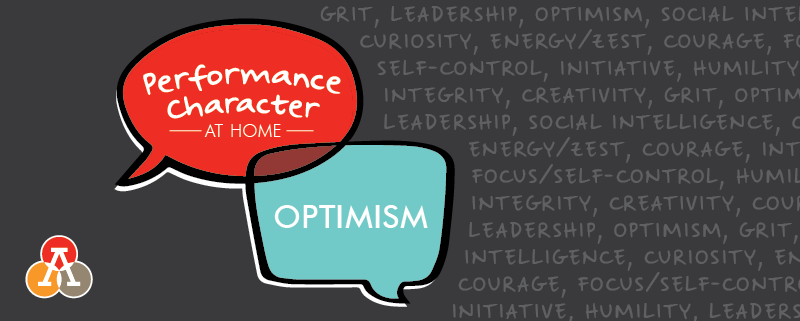Reinforcing Performance Character at Home: Optimism
“Optimism is the faith that leads to achievement. Nothing can be done without hope and confidence.”
– Helen Keller
At Athlos schools, we focus on teaching children the importance of 12 traits that we call Performance Character traits. Our Performance Character pillar recognizes the deep connection between these traits and success. The development of Performance Character is integrated into every learning opportunity, allowing students to experience this connection first hand. Traits like humility, integrity, courage, and optimism become a lens through which students view their learning as about more than grades, but as learning for life.
Like all important lessons, reinforcing learning at home is a key factor to success. One of the best ways for parents to do this is to positively model the traits at home and encourage trait development. In our 12-part ‘Performance Character at Home’ blog series, we offer simple, yet effective, ways to support children’s Performance Character development. In this blog, we look at optimism.
 What is optimism?
What is optimism?
Athlos defines optimism as: believing that effort today improves tomorrow
Why is optimism important?
Closely related to the Performance Character trait energy/zest, optimism focuses on developing a positive outlook on life. Optimistic children are more willing to take on challenges, create strong relationships with others, and turn failures into learning opportunities. Though studies have shown that happier students get better grades, optimism is about looking on the bright side despite what the report card says. Like hope, optimism is the feeling that setbacks are only temporary and that success is just around the corner.
How can I help my child develop optimism?
Optimism can be learned, but it takes practice. To help children think optimistically, it takes a gentle approach and a positive perspective.
Here are a few ways you can foster this trait at home:
- Children can easily become frustrated and fall into a pessimistic style of thinking. At this moment there are three steps you can follow to help avoid this habit:
- Acknowledge their feelings and empathize with their struggles, show them you understand
- Focus on the positive side of things, what they’ve done correctly
- Help them break down the problem into more manageable pieces, make realistic goals
- Help the child reframe successes and challenges. A successful grade can be explained as, “I did well because I was prepared. I can succeed in other areas as well, and my hard work made this possible.” Likewise, a setback can be explained as, “That was harder than I thought it would be. With a little more studying, I’ll do fine.”
- Create a safe space for the child to take risks. Some teachers have found that creating a safe space for children to take risks teaches them that failure is part of the learning process. This helps them view challenges as temporary obstacles. Whether they are riding their bike or writing their homework, helping children realize that it’s okay to make mistakes will cultivate more optimism than if they were not allowed to make any.
- Just as pessimism can be a habit, so can optimism. A great way to develop a positive mindset is to practice asking your family to name three things they are grateful for at the end of each day. By making this a routine, you and your children will develop the optimistic habit of looking for things to be grateful for.



